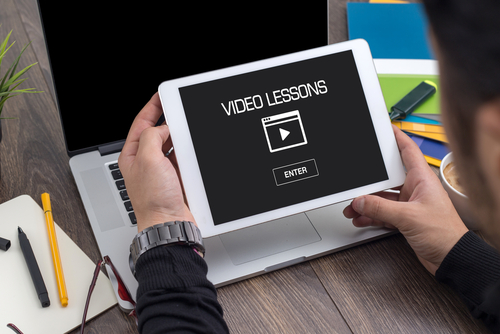If you’ve ever watched an educational video, you probably stared at the screen but didn’t retain much. Maybe your eyes glazed over and you drifted off, thinking about your grocery list instead. Sadly, this is an experience many of us can relate to. This problem arises when companies focus too much on technology and not enough on storytelling.
When done right, online learning videos can increase information retention and overall engagement. The total spend on online learning content is increasing, and it’s expected to reach a value of $435 billion by 2030. But are companies spending their money on the right tools? Let’s examine the three most common mistakes employers make when it comes to online learning.
Why Your Online Learning Content Sucks
When creating online learning content, there are a few common mistakes organizations make.
The first one is buying bulk content that lacks originality. With so many online learning options available, it can be tempting to buy an entire content library of 10,000 titles and use the same videos many other companies are using. Not only will these videos quickly lose your employees’ attention, but they’re oftentimes outdated and insensitive.
The second mistake is focusing solely on reducing costs when creating online learning content. This approach can backfire in the long run. While saving money in the short term may seem like a good idea, your content will be a lot less effective overall. Instead of skimping on production costs and risking retention, invest in high-quality vendors that can work within your budget to help you create engaging content. There’s a myth that video production companies are “just too expensive,” but this is simply not the case. Many video production companies are willing to work within your budget parameters.
Lastly, when filming your own content, don’t fall into the trap of thinking you can just “fix it in post.” If the content is poorly shot or written or the information is presented in a confusing way, editing can’t help, so planning is key. Have a solid plan in place from the outset to ensure the content is clear and engaging for learners.
How Do You Know If Viewers Are Engaged?
When content is good, people talk. They talk about bad content, too. However, it’s hard to find engaging online learning content, so word spreads quickly when people enjoy something they expect to be dull.
So, how do you create engaging content that gets your employees to talk? We believe it all starts with making your own content. Branding, storytelling, and company culture are huge factors in the content creation process. Find a tone and approach that works best for your brand identity.
For instance, if your company is quirky, you might want to make training fun and entertaining in addition to informational. Other companies may be more serious and refined, preferring a more tailored look and feel. The choice is yours. And the greatest perk is, because you own the content, you won’t have to license it year after year. Well-produced content can be updated rather than rerecorded time and time again.
Training Video Best Practices
Here are some tips on how to get started making video content that doesn’t suck.
1. Be honest with your production company. Let them know your budget so they can make the best suggestions for a quality video within the range. Know your budget ahead of time, and don’t believe the lie that video production companies are “too expensive.” Read reviews, choose a few options, and explain what you want to achieve and how much money you have to spend.
2. Focus on all the small details. When creating online learning content, be thoughtful about every detail that’s going to make your content stand out. What’s your background going to be? How does that background add to the story you’re going to tell? Who’s each person in your video? Sometimes it helps to develop entire character personas before you begin filming rather than assigning someone a name and a few lines. Are you going to have your characters move around? Is the camera going to move around? If you’re talking about diversity, do you have a diverse team on and off camera? These are all questions to think through before you begin filming. If you partner with a professional film production company, these are all things they can help you think through, as well.
3. Tell a story. Storytelling is one of the most effective content formats for online learning. Telling a story is far more memorable than having a talking head stare into the camera. A historical study shows people are way more likely to remember things when told in the form of a story. When you think through your script, use your character descriptions to develop an engaging story with a theme, conflict, resolution, and unique point of view.
Original online learning content has the potential to increase information retention rates when it comes to corporate and HR training materials. To avoid common mistakes, invest in high-quality vendors, have a solid plan from the outset, and prioritize engaging storytelling. It’s much easier to put in the hard work on the front end than spend time fixing problems on the back end. Take it from us.
Rachel Klein is a producer, director, and the CEO of Fire Starter Studios. She is a two-time Primetime Emmy and Producers Guild Award nominee with over 600 hours of television programming under her belt. Rachel is an industry expert in documentary and animation production. She has produced outstanding content for Showtime, HBO, Fox, and ABC; Fortune 500 companies such as Microsoft Corp., Cisco Systems Inc., and Time Inc.; and government entities such as the U.S. Department of Defense and the National Endowment for the Arts. She currently sits on the national board of directors for the Producers Guild of America and is a member of the Academy of Television Arts & Sciences.

